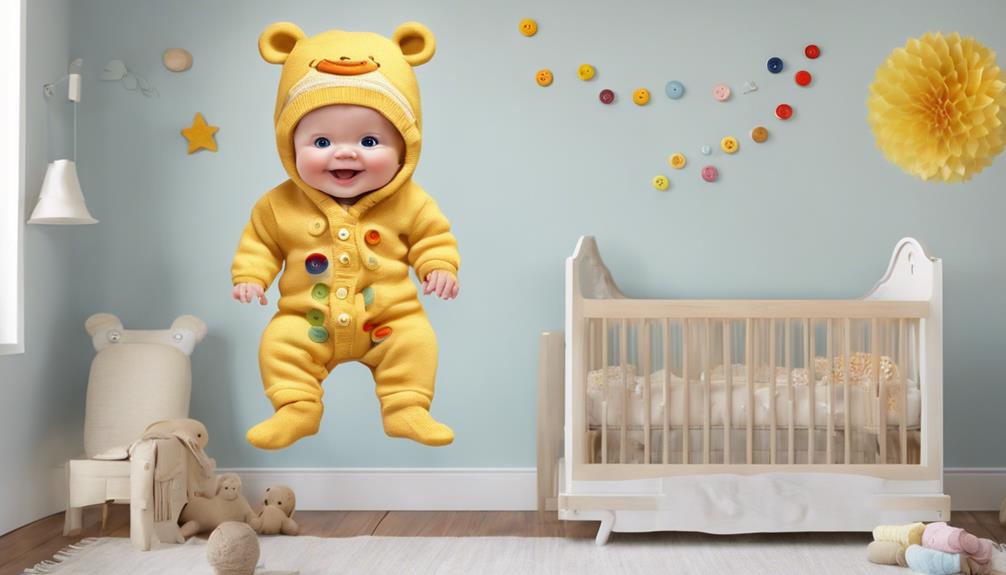As new parents, we frequently find ourselves balancing between comforting a fussy newborn and searching desperately for explanations for their enigmatic sleep patterns.
Imagine finally settling your baby down for the night, only to have them wake up every hour, leaving you exhausted and bewildered.
But fear not, there is a light at the end of the tunnel. By understanding the intricacies of newborn sleep patterns week by week, we can unravel the secrets to a more restful night for both baby and parents.
Key Takeaways
- Encourage full feeds every 2-3 hours to support newborn sleep patterns.
- Establish a structured sleep schedule to help babies adjust to consistent rest.
- Implement soothing techniques and a calming bedtime routine for smooth sleep transitions.
- Promote longer periods of rest by regulating sleep cycles and creating a comfortable sleep environment.
Week 1: Establishing Newborn Sleep Patterns
In our first week with a newborn, prioritizing establishing healthy sleep patterns that align with their natural rhythms is essential. Newborns at this stage typically sleep for 16-20 hours a day, with short and frequent intervals of wakefulness. It's common for babies to experience day-night confusion as their circadian rhythm develops, leading to more wakefulness at night. To help your newborn differentiate between night and day, try to keep the sleep environment dark and quiet during nighttime feedings and diaper changes.
Feeding plays a significant role in setting a routine for your baby. Encouraging full feeds every 2-3 hours can't only guarantee they're getting the nutrition they need but also aid in establishing a feeding and sleep schedule. Since newborns in their first week may struggle to stay awake for extended periods, offering frequent naps throughout the day can help prevent overtiredness and support better sleep patterns at night. Remember, patience and gentle guidance are key as you navigate this initial stage of your newborn's sleep journey.
Week 2: Implementing a Sleep Routine

As we enter Week 2 with our newborn, establishing a structured sleep routine becomes pivotal to nurture their developing sleep patterns. During this time, babies typically sleep around 16 hours a day, with sleep occurring in fragmented intervals to support their rapid growth and development. Day/night confusion may still be present, so incorporating short periods of wakefulness during the day can aid in helping babies adjust to a more consistent sleep schedule.
To set up a reliable sleep routine, consider incorporating regular feedings and naps every 2-3 hours. This consistency can assist in regulating newborn sleep patterns and promoting better rest. Creating a clear distinction between day and night environments by maintaining bright conditions during the day and dimming lights at night is crucial. Starting this structured routine from morning to night around week 2 can contribute to improved sleep habits and overall well-being for your newborn as they continue to adapt to their new world.
Week 3: Understanding Infant Sleep Cycles

Understanding infant sleep cycles at week 3 is important for effectively managing your newborn's sleep patterns. At this stage, your baby experiences short sleep cycles lasting around 45 minutes to an hour, moving from light to deep sleep stages.
To support your little one during this important period, consider implementing the following strategies:
- Consistent Soothing Techniques: Newborns at week 3 benefit from gentle and consistent soothing methods to help them navigate through different sleep stages smoothly.
- Encouraging Self-Soothing Behaviors: Promoting self-soothing behaviors can assist in enhancing sleep continuity, allowing your baby to settle back to sleep independently during awakenings.
- Establishing a Calming Bedtime Routine: Introducing a calming bedtime routine can aid in creating a conducive environment for your infant to relax, making it easier for them to fall asleep and stay asleep longer.
Week 4: Developing a Sleep Schedule

Exploring week 4 with your newborn involves developing a structured sleep schedule to support their growth and well-being. As your baby moves into their fourth week of life, establishing healthy sleep habits is essential for their overall development. At this stage, infants typically need around 14-16 hours of sleep daily to aid in their rapid growth. Some babies may start to experience longer stretches of sleep at night, indicating the beginning of more predictable sleep cycles.
To assist you in creating a suitable sleep schedule for your newborn, we have crafted a sample sleep schedule table below. This table outlines suggested nap times, feeding schedules, and bedtime routines to help you structure your baby's day effectively. Remember, consistency is key when implementing an infant sleep schedule. Additionally, ensuring a comfortable and safe sleep environment plays a crucial role in fostering healthy sleep habits. By monitoring your baby's sleep patterns and making adjustments as needed, you can support their well-being during this critical developmental stage.
| Time | Activity | Notes |
|---|---|---|
| 7:00 AM | Wake Up | Begin the day with a morning feed |
| 9:00 AM | Nap | Keep the room dimly lit for a restful nap |
| 12:00 PM | Feeding | Offer a soothing feeding session |
| 3:00 PM | Nap | Encourage a peaceful mid-afternoon nap |
| 7:00 PM | Bedtime Routine | Establish a calming bedtime routine |
Week 5: Addressing Common Sleep Issues

Moving into week 5 with your newborn brings a focus on addressing common sleep issues that may arise as your baby continues to grow and develop. Understanding that babies start to exhibit more predictable sleep patterns around this time, establishing a structured sleep schedule becomes crucial.
To help you navigate through this stage, consider the following:
- Establishing Routine: Creating a consistent bedtime routine can signal to your baby that it's time to wind down and prepare for sleep.
- Self-Soothing Techniques: Introducing techniques like offering a pacifier can assist your baby in learning to settle back to sleep independently during the night.
- Structured Sleep Schedule: Developing a structured sleep schedule can help regulate your baby's sleep cycles and promote longer periods of rest.
Frequently Asked Questions
How Do I Establish a Sleep Pattern for My Newborn?
We establish a sleep pattern for newborns by observing their cues, creating a cozy sleep environment, and sticking to a soothing routine. It's important to adjust based on their needs for better sleep quality and duration.
What Is the Recommended Sleep Schedule for a Newborn?
For newborns, a recommended sleep schedule includes 14-17 hours of sleep daily, with shorter stretches day and night. Longer night sleep is beneficial. Following cues, we establish a routine. It's important for our baby's well-being.
When Do Babies Sleep 7pm to 7am?
We found that many babies start sleeping from 7pm to 7am around 3-4 months old, hitting the milestone of sleeping through the night by 6 months. Consistent routines and sleep environments play an important role in achieving this.
When Should I Start My Baby's Sleep Routine?
We should start our baby's sleep routine around 6-8 weeks to establish healthy habits. Building a consistent bedtime routine early on promotes better sleep patterns. Incorporating calming activities like a warm bath signals it's time to sleep, aiding longer, more restful stretches.
What Effect Does Dressing Have on a Newborn’s Sleep Patterns?
The right newborn sleep clothing tips can make a difference in your baby’s sleep patterns. Dress your baby in comfortable, breathable fabrics to help regulate their body temperature. Avoid overdressing or using blankets in the crib to reduce the risk of Sudden Infant Death Syndrome (SIDS). Prioritize safety and comfort when choosing sleepwear for your newborn.
Conclusion
We hope this guide has been helpful in managing your baby's sleep patterns week by week. Remember, consistency is key when establishing a sleep routine.
Don't be discouraged by challenges along the way – with patience and perseverance, you can help your little one develop healthy sleep habits.
So, keep calm and carry on, knowing that you're doing a fantastic job in nurturing your newborn's sleep!










